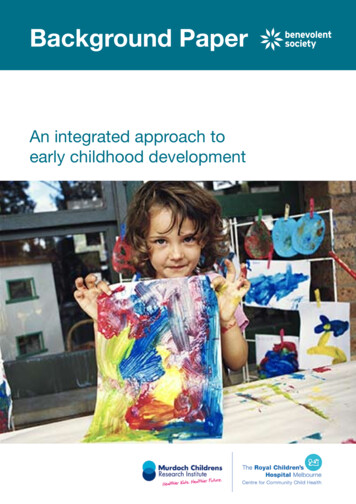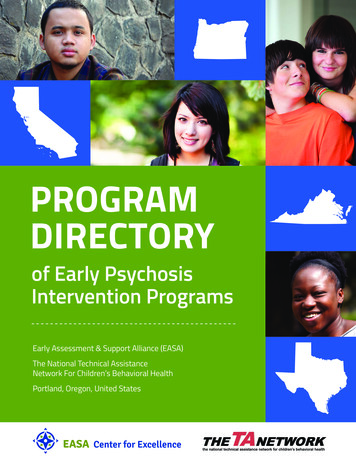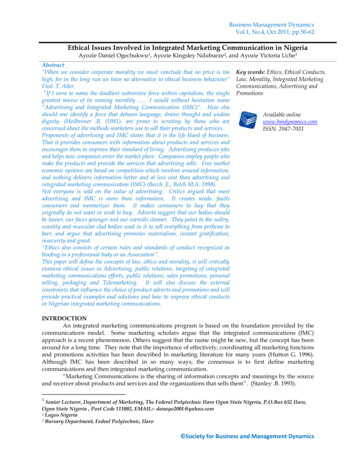
Transcription
Background PaperAn integrated approach toearly childhood development
About The Benevolent SocietyThe Benevolent Society is Australia’s oldest charity. Established in 1813 we have been caring forAustralians and their communities for nearly 200 years. We are a secular, non-profit, independentorganistation working to bring about positive social change in response to community needs. Ourpurpose is to create caring and inclusive communities and a just society.Prepared for The Benevolent SocietyPrepared by Centre for Community Child Health, MelbourneWritten by Dr. Tim Moore (Senior Research Fellow) and Alexandra Skinner (Project Officer)September 2010ISBN 978-0-9807720-3-6The Benevolent SocietyLevel 1,188 Oxford StreetPO Box 171Paddington NSW 2010t 02 9339 8000f 02 9360 2319e mailben@bensoc.org.auwww.bensoc.org.au
Background PaperAn integrated approach to early childhood developmentSeptember 2010ContentsExecutive Summary. 11. Introduction. 32. The big picture: climate change and social climate change. 43. Moving towards integrated service delivery: government policies and initiatives. 64. Service systems and government support: what works for children and families. 85. Building an integrated service system: what we can do. 126. Forms of collaboration and integration. 157. Existing models of service integration. 208. Improving service integration: what we have learned. 259. Priorities and recommendations. 2910. Conclusion. 3511. References. 36
Page Background PaperAn integrated approach to early childhood developmentSeptember 2010Executive summaryMajor social, demographic and economicchanges in Australia over the last 50 yearshave dramatically altered the conditionsin which families are raising children.There is evidence that a significantnumber of children are facing worseningdevelopmental and social outcomes as aresult of this ‘social climate change’.Service delivery integration can take theform of ‘virtual’ or co-located integration.Different forms of service level integrationfall along a five-point continuum rangingfrom coexistence (where services operateindependently) to full integration (whereservices merge completely to form a newentity).The system of services for children andfamilies is struggling to cope with families’increasingly complex needs in the face ofthis rapid societal change. Services arefragmented, and the system is difficult forfamilies to understand and access. Theservice system needs to be reconfigured tobetter meet families’ needs.Teamwork integration requiresprofessionals to work in teams withmembers of different disciplines. Types ofteam integration range from unidisciplinaryteamwork (where one discipline attemptsto meet all the needs of families) totransdisciplinary teamwork (where teammembers share roles and cross disciplineboundaries).Research suggests that, while an integratedservice system would not directly improvefamily functioning and children’s wellbeing,it would contribute to those outcomes byimproving access to services and enablingearly identification of problems.There are four levels at which integrationneeds to occur:Government/policy integration is basedon the recognition that the wellbeing ofchildren is not the responsibility of anyone department. At this level, policy andplanning are integrated across governmentportfolios, departments and agencies.Regional and local planning integrationinvolves the establishment of an earlyyears partnership group to drive localintegration. Strategies include mappingcommunity assets and needs; developingan integration plan; and simplifyingparental access to services throughsingle entry points. An important focusis the linking of specialist services withmainstream or universal services.Two of the most notable efforts to integratechild and family services are Sure Start inthe UK and Toronto First Duty in Canada.Both models bring together a range ofservices in one centre, including earlyeducation and care, parenting support,child and family health services, and helpwith employment. Evaluations of bothmodels have found benefits for children andfamilies.There is recognition in Australia of the needfor an integrated child and family supportsystem. Over recent years there has beenan unprecedented level of collaborationbetween federal and state governmentsin developing policies and frameworksfor early childhood services. While acomprehensive, integrated child and familysupport system has yet to be developed,there are some promising initiatives.At a national level, The Department ofFamilies, Housing, Community Servicesand Indigenous Affairs established itsCommunities for Children (C4C) initiativeto promote a local partnership approach
Page Background PaperAn integrated approach to early childhood developmentSeptember 2010to planning and delivering services.Established in 45 sites, the program aimsto improve children’s health, safety andwellbeing in disadvantaged communities. Alocal non-government organisation (NGO)works with the community to identify needsand develop appropriate strategies. ThisNGO acts as a broker, engaging otherlocal organisations to help deliver thosestrategies. The model aims to increaseservice coordination and collaboration.At a regional level, integration initiativesinclude Families NSW, a servicecoordination program established in 1998which attempted to integrate planning atthe government level. However, subsequentchanges to the program have reducedits effectiveness as a comprehensiveregional planning process. Also in NSW, theSchools as Community Centres programruns 51 projects in partnership withfamilies, communities and agencies. It runssupported playgroups and activities relatingto early literacy and transition to school.In Victoria, the Best Start program buildslocal partnerships between parents,services and government agencies topromote better service coordination andjoint strategic planning. The Primary CarePartnerships initiative in Victoria aims toimprove integration between services withinthe primary health care system.International and Australian experiences ofintegration provide some evidence of theimpact that integration has and how bestto achieve it. Evidence of the impact ofintegration is somewhat limited. Researchsuggests that it is the quality, ratherthan type, of integration that matters forimproving outcomes. Integrated workingonly benefits families if it results in higherquality interventions.There is more evidence about the processof integration, which confirms that it is achallenging process requiring commitment,enthusiasm and careful planning.Research highlights a number of barriersto, and factors that promote, successfulcollaboration. These include issues relatingto management and leadership, financingand resourcing, timeframes, and culturaland ideological differences.There are a number of ‘next steps’ thatwould lead to greater integration ofAustralia’s child and family service system.These include embedding targeted servicesinto mainstream services; early yearspartnerships that drive local integration; andgovernance and funding models that enablesustainable partnerships. This paper makesrecommendations to governments andservice delivery organisations on how bestto move towards integration.
Page Background PaperAn integrated approach to early childhood developmentSeptember 20101. IntroductionThis paper was commissioned by TheBenevolent Society (TBS) to provide adviceon how to move towards greater integrationof the various elements of support and/or services needed by children and theirfamilies.The paper was prepared by Dr. Tim Moore,Senior Research Fellow, with assistancefrom Alexandra Skinner, Project Officer,from the Centre for Community Child Health(CCCH), Melbourne. Preparation of thepaper was based on a number of sources:reviews and syntheses of relevant literature(both peer-reviewed and ‘grey’ literature);reviews of relevant Australian federal andstate policies and initiatives; reviews ofrelevant international policies and initiatives;and a workshop with TBS managersand policy staff. The paper also drawsupon CCCH’s considerable experience insupporting the development of integratedearly childhood services.The paper includes: a synthesis of evidenceregarding societal change and its impacton children, families and communities;the response of governments to thesechanges; and what is known about effectiveservices, service systems and governmentpolicies. The paper also includes a reviewof evidence regarding integrated servicedelivery, service systems and policies,and an analysis of current opportunities inNSW and Queensland for greater serviceintegration.
Page Background PaperAn integrated approach to early childhood developmentSeptember 20102. The big picture: climate changeand social climate changeThe changes that have occurred overthe past 50 years have been so rapidand so far-reaching that they have hada dramatic impact on the physical wellbeing of the planet (in the form of climatechange) (Flannery, 2005; Garnaut, 2008;Intergovernmental Panel on Climate Change,2007; Steffen et al., 2004), as well as on thephysical and psychosocial well-being ofsocieties (social climate change)(Moore,2009).The effect of these changes can be seenin the health and well-being of childrenand young people. While most children aredoing well, there is evidence of worseningor unacceptably high levels of problemsin a minority of children (Bruner, 2004;Eckersley, 2008; Li, McMurray & Stanley,2008; Perrin et al., 2007; Stanley et al.,2005; Richardson & Prior, 2005). Theseproblems are evident across all aspectsof development, health and well-being,including mental health (eg. depression,suicide, drug dependence), physicalhealth (eg. asthma, obesity, diabetes,heart disease), academic achievement (eg.literacy levels, retention rates, educationaloutcomes), and social adjustment (eg.employment, juvenile crime). These problemsare ‘disorders of the bioenvironmentalinterface’ (Palfrey et al., 2005) rather thanconditions with separate or singular causes,and the developmental pathways that lead tomost of these outcomes can be traced backto early childhood. This is reflected in thesignificant numbers of children who arrive atschool poorly equipped to take advantageof the social and learning opportunities thatschools provide (Centre for Community ChildHealth and Telethon Institute for Child HealthResearch, 2007, 2009).The profound social changes that haveoccurred over the past few decades havealso altered the circumstances in whichfamilies are raising young children –parenting has become more challenging, andthe stakes are continuing to rise the more welearn about the importance of the early yearsand the more we understand about the skillsthat are needed to function successfully in acomplex interconnected world. The currentservice system was designed at a time whenfamily circumstances were simpler andparenting less challenging, and is strugglingto meet all the needs of all families effectively(Moore, 2008).Specific problems faced by the servicesystem include the following (Moore, 2008): the service system is having difficultyproviding support to all families who areeligible – there are waiting lists for manyservices services cannot meet all the needs offamilies that they serve - no single serviceis capable of meeting the complex needsof many families families have difficulty finding out aboutand accessing the services they need– there is no single source of informationabout relevant services services are not well integrated withone another and are therefore unable toprovide cohesive support to families services have difficulty tailoring theirservices to meet the diverse needs andcircumstances of families services are typically focused and/orfunded on the basis of outputs ratherthan outcomes, and therefore tend topersist with service delivery methods thatmay not be optimally effective services are typically treatment-orientedrather than prevention - or promotionfocused, and therefore cannot respondpromptly to emerging child and familyneeds
Page Background PaperAn integrated approach to early childhood developmentSeptember 2010 child care and early childhood educationservices are funded and run separately government departments, researchdisciplines and service sectors tend towork in ‘silos’ responsibility for provision of servicesto children and their families is spreadacross three levels of government federal, state, and local - with differentplanning processes and fundingpriorities most specialist intervention services arealready underfunded, and it is lookingincreasingly unlikely that they can everbe fully funded in their present forms.As a result of the difficulties that the currentsystem of services is experiencing, manychildren are not receiving the additional helpthey need (Sawyer et al., 2000; Sayal, 2006).It is often those with the greatest needthat are least likely to be able to accessavailable services (Fonagy, 2001; Offord,1987; Watson et al., 2005).Perhaps the most dramatic examples of theproblems being experienced by traditionalservice systems is the crisis facing childprotection systems (Scott, 2006; O’Donnellet al., 2008; Allen Consulting Group, 2009).However, all other service sectors areexperiencing similar challenges, and forsimilar reasons.Accompanying these changes has been theemergence of a class of complex problemsaffecting children and families that cannotbe effectively addressed by individualinterventions or forms of service. The poordevelopmental and social outcomes weare witnessing in our young people needto be understood as the cumulative resultof complex interactions between a hostof social and other factors (Kearns et al.,2007). These complex manifestationsare sometimes referred to as ‘wickedproblems’, not in the sense of them beingevil in some way, but in the sense of thembeing complex and difficult to solve, andrequiring action on multiple fronts and levels(Australian Public Services Commission,2007; Conklin, 2006; Rittel & Webber, 1973).In the light of these problems, it hasbecome increasingly obvious that the earlychildhood and family support system needsto be reconfigured to meet the needs ofcontemporary families more effectively.The next section outlines the ways inwhich governments have responded to thischallenge.
Page Background PaperAn integrated approach to early childhood developmentSeptember 20103. Moving towards integrated service delivery:government policies and initiativesAll developed nations have taken actionto address these changed circumstances.Some have been driven by a growingawareness of the ways in which somepeople within society are failing to benefitfrom the changed social and economicconditions and are therefore achievingpoorer outcomes. This has, in turn, led togeneral public policy initiatives in Australiaand elsewhere to address social exclusionand promote a truly inclusive society.Other initiatives have focused on the needsof young children and their families, andways of integrating early childhood andfamily support services. Sometimes thesetwo goals are addressed within the sameinitiative. International examples of suchresponses include the UK’s Every ChildMatters policy and Sure Start initiatives, andCanada’s Toronto First Duty program.In Australia, there have been a number offederal initiatives over the past decade orso. These include the Stronger Families andCommunities strategy (and it’s Communitiesfor Children initiative) and the currentGovernment’s Early Childhood Developmentstrategy. The Federal Government hasalso worked with the Council of AustralianGovernments (COAG) which has endorseda number of national policies and initiativesaimed at young children and families. AllAustralian States have also taken actionto develop early childhood policies andintegrate early childhood services.The move towards more integrated servicedelivery has been driven by a growingawareness of how fragmented services foryoung children and their families are, andhow that fragmentation undermines thecapacity of the service system to supportchildren and families effectively. All theproblems identified earlier – wherebyplanning, funding and services delivery aremanaged by different levels of government,different departments and differentagencies all operating independently of oneanother – result in a service system thatcan be difficult for families to understandand access. The families that are mostdisadvantaged by this situation are thosethat are most vulnerable – whether becausethey lack the skills and confidence tonegotiate the system, or because they areunfamiliar with the culture and language,or because they are isolated and lack thesocial networks that would help them findand use the services that are available, orbecause they have multiple problems andneed help from many sources.The fragmentation of services isparticularly problematic for the families ofchildren below school age because thereis no universal service that all familiesuse during these years. All children areknown to the service system at birth andat school entry, but the contact they havewith early childhood and other servicesbetween those two points varies greatly.Some families make regular use of thevarious health, early childhood and familysupport services during these years, whileothers make little or no use of them, evenif they have concerns about their childrenor are experiencing family difficulties(Carbone, Fraser, Ramburuth and Nelms,2004). In such cases, the service systemcannot respond promptly to issues asthey arise and may only become involvedlater when the problems have becomemore entrenched and severe. The lack ofa universally used early childhood servicehas been one of the problems that movesto integrate services are intended toaddress.Besides the moves to integrate services,the various policies and initiativesundertaken by governments in Australia
Page Background PaperAn integrated approach to early childhood developmentSeptember 2010and elsewhere share a number of commonfeatures. These include: finding more effective ways of reachingvulnerable children and familiesensuring that all children arrive at schoolready to learnshifting services to a promotion /prevention focusreducing child protection ratesmonitoring children’s development andwell-being more effectivelyimproving the quality of early childhoodservicesincreasing the use of evidence-basedpractices.Many of these themes can be seen in therecommendations emerging from recentreviews of child protection systems invarious jurisdictions (eg. COAG, 2009;Wood, 2008) and other analyses (eg. AllenConsulting Group, 2009; Higgins and Katz,2008; O’Donnell, Scott and Stanley, 2008;Scott, 2006). These all point to the same setof solutions: a move to preventive practices,a focus on promoting the well-being of allchildren, and a coordinated approach toaddressing problems as they emerge. Forinstance, the recent Report of the SpecialCommission of Inquiry into Child ProtectionServices in NSW supports the premise ofshifting child protection to a preventionapproach that utilises a range of services toachieve that goal. The report states:‘ child protection systems shouldcomprise integrated universal,secondary and tertiary services, withuniversal services comprising thegreater proportion. They should bedelivered by a mixture of the nongovernment sector and state agencies,with DoCS being a provider of lastresort.’ (Wood, 2008)Similarly, the Council of AustralianGovernments’ new National Frameworkfor Protecting Australia’s Children (COAG,2009) takes the view that protecting childrenis everyone’s business, and that Australianeeds to move from seeing ‘protectingchildren’ merely as a response to abuse andneglect to one of promoting the safety andwell-being of children.Another common feature of all thesepolicies and initiatives is that none of themhave succeeded as yet in making significantimprovements in child and family outcomes.One reason for this is that our efforts toalter the circumstances in which families areraising young children are relatively modestso far, and have not been in place longenough to begin to counteract the effectsof social climate change. Another reason isthat we have not yet clearly identified howto reconfigure the service system so as tosupport families more effectively. The nextsection addresses this question.
Page Background PaperAn integrated approach to early childhood developmentSeptember 20104. Service systems and government support:what works for children and familiesTo understand fully how best to supportyoung children and their families, we needto take into account what we know aboutchild development, family functioning,community functioning, direct servicedelivery, service systems and the role ofgovernment. These do not develop orfunction independently of one another, butconstitute different levels of a complexsocial ecological system in which each levelaffects and is affected by the levels closestto it (Bronfenbrenner, 1979; Bronfenbrenner& Ceci, 1994; Bronfenbrenner & Morris,1998).Because the focus of this paper is on howto move towards greater integration of thesupports and services needed by childrenand their families, we will concentrate onthe last two of these key elements only:what is known about service systems andabout the role of government. Universal and inclusive service base.The core services are available toeveryone and designed to be inclusive,non-stigmatising and welcoming. Theusual approach to addressing the needsof vulnerable or exceptional familieshas been a targeted approach whichinvolves supplementing a relativelynarrow band of universal services (eg.maternal health services) with a rangeof targeted programs that provideadditional services to individuals,groups or localities identified as beingat risk. There are good grounds, bothempirical and theoretical, for adopting auniversal approach to service provision,strengthening the range of universalservices and providing additionalservices in response-based fashion(according to emerging needs ratherthan risks). Information provision. Parents haveaccess to information in various formsregarding the community facilities andprofessional services that are available. Range of services. Families haveaccess to a broad range of interventionswhich include both practical, materialservices and more complex work (suchas enhancing parenting skills), includingopportunities to be engaged in theirchildren’s learning. Multiple interventions. Programs usingmultiple interventions addressing severalrisk areas work better than those using asingle intervention strategy. Service redundancies. Services areprovided in a range of formats andlocations to suit the different needs andpreferences of diverse groups. Thus,parenting services might be availablein formal (eg. Triple P) and informal (eg.facilitated playgroups) formats. Multipleformats are needed because of evidenceService systemsWhat do we know about how best toorganise services into a system thateffectively supports families of youngchildren in rearing their children asthey (and we) would wish? There isa considerable research literature onwhat makes service systems effectiveand what problems parents of youngchildren experience in accessing andusing services. Based on analyses andresearch reviews by Allen ConsultingGroup (2008), Beresford & Hoban (2005),Boston Consulting Group (2008), Centrefor Community Child Health (2007, 2008,2009), Fine et al. (2005), Lewis (2010),Pope & Lewis (2008), Soriano et al. (2008),Watson (2005), and Watson et al. (2005),the key features of effective integratedservice systems for vulnerable families areas follows:
Page Background PaperAn integrated approach to early childhood developmentSeptember 2010to suggest that the most vulnerablefamilies may be deterred from usingchildren’s centres if they perceive acritical mass of more affluent, assertiveand confident parents to be dominatingthe use of services. Accessibility. Services are made asaccessible (in all senses, includinggeographical, cultural and psychologicalaccessibility) as possible. Activeassistance (eg. with transport orinterpreters) is provided as required. Multiple single entry points. Thereare multiple entry points and no ‘wrongdoor’: whatever service a child isbrought to should either provide help, orhelp find a more suitable service that iseasy to access. ‘Soft’ and ‘hard’ entry points. A mixof ‘soft’ and ‘hard’ entry points to theservice system is provided. Universalservices can be used to provide animportant soft entry point of first contact,whereby parents can access support tomore specialised services. Integrated services. Some coreservices are integrated, either as a‘virtual’ network or an actual co-locatedservice (as in service hub models andchildren’s centres). Embedded specialist services.Specialist or targeted services areembedded in universal services (eg.schools, maternal and child healthcentres, churches, libraries and healthclinics). Active / assertive outreach. There areoutreach services designed to find andbuild relationships with vulnerable andmarginalised families, and link them withservices that match their needs andpreferences. Mentoring. ‘Experienced’ parents arerecruited to act as mentors for ‘new’parents. Mentoring helps to achievepositive outcomes with various clientgroups, such as young parents andisolated parents. Community-based early yearspartnerships. The planning andmanagement of integrated servicesystems requires the establishmentof community-based early yearspartnerships. Articulation of a shared vision andachievable goals. It is important to havea strong vision with clear objectivesand achievable goals. A shared visionprovides a platform for building sharedresponsibility and accountabilitybetween organisations and sectors,providing a base for collective action,planning and service delivery. Problemsarise when policy objectives are vague orthere are too many goals to be reachedin a short time. Facilitation capacity. Effective servicesystems usually have an identifiedperson or agency that is funded tofacilitate / coordinate collaborationbetween services, and support the workof early years partnerships. Integrated governance arrangements.The sustainability of communitybased early years partnershipsdepends upon establishing integratedgovernance arrangements that involveall stakeholders and provide a structurefor leadership and processes for fundingand accountability. Building a supportive culture. Effectiveintegrated systems require a supportiveculture based on collaboration betweenservices, mutual respect and trustbetween professional groups andproviders, and shared responsibility forvulnerable families and children.
Page10Background PaperAn integrated approach to early childhood developmentSeptember 2010 Active community participation.Parents and other community membersshould be active participants in theplanning, delivery and evaluation ofintegrated services. Commitment and support from seniorlevels of government. The success ofintegrated service networks depends onsupporting coordination in the field withparallel coordination within governmentand planning bodies.In addition to these structural propertiesof effective integrated service systems, anumber of vital process qualities have beenidentified: how services are delivered is asimportant as what is delivered. Key processqualities include: Engagement with parents. The successof integrated services ultimately dependsupon the level of engagement and thequality of the relationships establishedbetween professionals and parents, atboth individual and group levels. Partnerships with parents. Effectiveservices work with parents as partnersusing family-centred practice principles. Empowerment of parents. Effectiveservices help parents develop new skillsand competencies in meeting the needsof their children and families, and inmaking full use of early childhood andfamily support services.With these structural and process featuresof effective service systems in mind, whatdo we know about the extent to whichearly childhood and family support servicesin Australia are organised in the waysthat effectively support families in theirchildrearing roles?While Australia has a well-establishedtradition of providing early childhood andfamily support services, these are notgenerally organised into service systemsthat have the features listed above. Fora start, the service systems are not trulyuniversal (in the sense of being available toall people in all localities) or fully inclusive,and levels of provision vary between states.Our service systems also lack single entrypoints, outreach services for vulnerablefamilies, governance structures for earlyyears partnerships, and funding for afacilitator role. A good start has been madeon some of the other key features – such asdeveloping integrated hubs or centres, andestablishing community-based early yearspartnerships – but these initiatives have notyet become a consistent feat
organistation working to bring about positive social change in response to community needs. Our purpose is to create caring and inclusive communities and a just society. Prepared for The Benevolent Society Prepared by Centre for Community Child Health, Melbourne Written by Dr. Tim Moore (S











